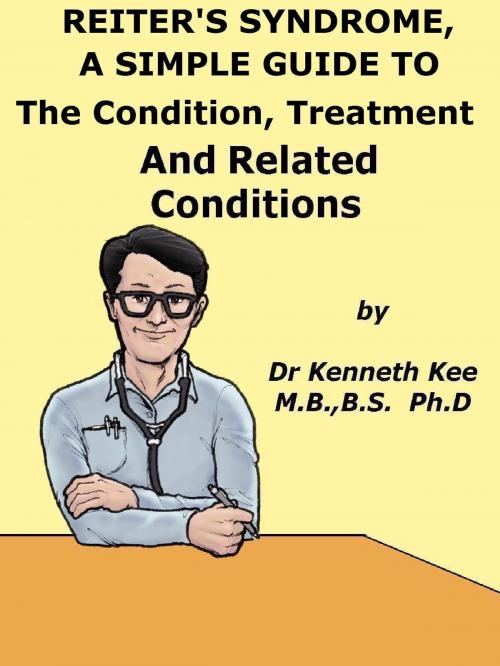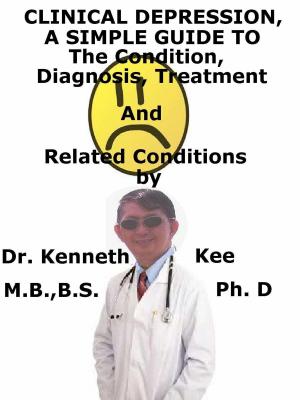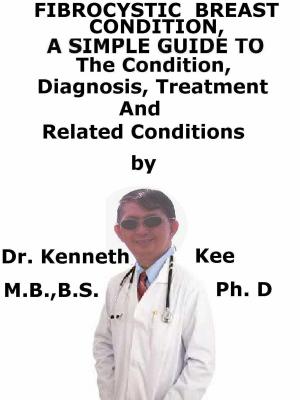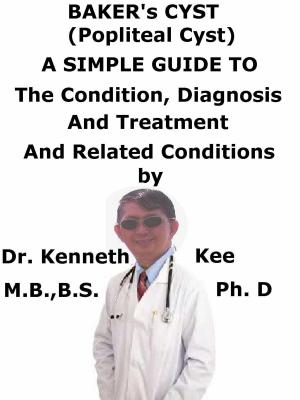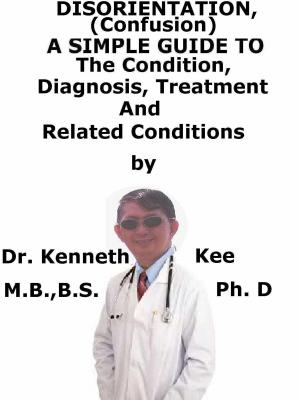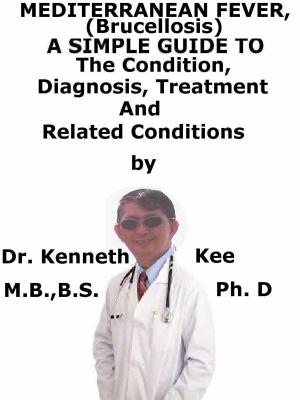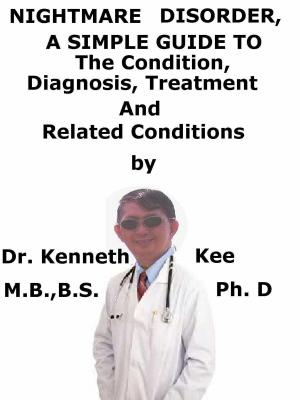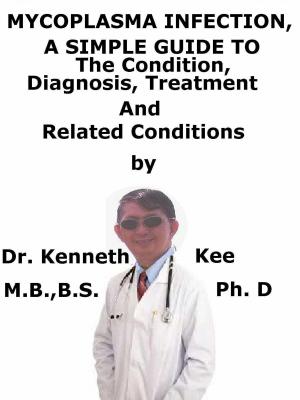Reiter’s Syndrome, A Simple Guide To The Condition, Treatment And Related Conditions
Nonfiction, Health & Well Being, Medical, Medical Science, Immunology, Health| Author: | Kenneth Kee | ISBN: | 9781311567536 |
| Publisher: | Kenneth Kee | Publication: | January 17, 2015 |
| Imprint: | Smashwords Edition | Language: | English |
| Author: | Kenneth Kee |
| ISBN: | 9781311567536 |
| Publisher: | Kenneth Kee |
| Publication: | January 17, 2015 |
| Imprint: | Smashwords Edition |
| Language: | English |
Reiter's syndrome is also known as reactive arthritis
It has the triad of symptoms of urethritis, arthritis and uveitis
It cause stiffness of the spine especially in the morning
Pain in the back, knees, and toes may soon start coming
Reactive arthritis occur when a joint reacts to an infection
Infection of the urethra and gut can cause joint inflammation
Redness of the eye, no pain and no blurred vision is conjunctivitis
Redness of the eye, pain and blurring of vision usually means uveitis
A gene HLA-B27 is present; so is increase in the ESR rate
Urine test may show the presence of infection of the urinary tract
If there is evidence of infection an antibiotic is given
Rashes of small nodules on the soles is quite common
Treatment with pain killers will stop the joint pain
Exercise will also help increase the flexibility again
Steroids may be injected into painful joints to reduce inflammation
Immunosuppressants may be necessary to reduce autoimmune reaction
-An original poem by Kenneth Kee
Interesting Tips about the Reiter's Syndrome
A Healthy Lifestyle
-
Take a well Balanced Diet
-
The main goal of treatment of Reiter's syndrome is to identify and eradicate the underlying infectious source with the appropriate antibiotics if still present.
Otherwise, treatment is symptomatic for each problem.
a. Analgesics particularly NSAIDs, sulfasalazine, steroids and immunosuppressants may be needed for patients with severe reactive symptoms that do not respond to any other treatment.
b. Antibiotics -- if you still have the bacterial infection that triggered Reiter syndrome.
c. Nonsteroidal anti-inflammatory drugs (NSAIDs) -- lower inflammation.
These drugs include ibuprofen (Advil, Motrin), naproxen (Aleve), and prescription drugs.
d. Corticosteroids -- may be injected into painful joints to reduce inflammation.
e. Drugs that suppress the immune system -- such as sulfasalazine or methotrexate; may be given in more serious cases.
f. Tumor necrosis factor (TNF) inhibitors -- these drugs block a protein that causes inflammation in the body.
They may be used in more severe cases and are also used to treat rheumatoid arthritis.
TNF inhibitors include etanercept (Enbrel), infliximab (Remicade), and adalimumab (Humira)
- Keep bones and body strong
Bone marrow produces our blood
Eat foods rich in calcium like yogurt, cheese, milk, and dark green vegetables.
Eat foods rich in Vitamin D, like eggs, fatty fish, cereal, and fortified milk.
Eat food rich in Vitamins B and C such as green vegetables and fruits
Zinc and other minerals are important to the body
- Get enough rest and Sleep
Avoid stress and tension
- Exercise and stay active.
It is best to do weight-bearing exercise such as walking, jogging, stair climbing, dancing, or lifting weights for 2½ hours a week.
One way to do this is to be active 30 minutes a day at least 5 days a week.
Begin slowly especially if a person has not been active.
- Do not drink more than 2 alcohol drinks a day for a man or 1 alcohol drink a day for a woman.
Alcohol use also increases the chance of falling and breaking a bone.
Alcohol can affect the neurons and brain cells.
Sensitivity of the nerves to the bone may be affected
- Stop or do not begin smoking.
It also interferes with blood supply to the bone and spine.
Reiter’s Syndrome
Some people had arthritis, urethritis and conjunctivitis at the same time.
This triad of symptoms became known as Reiter's syndrome.
Some people use the term Reiter's syndrome for all cases of reactive arthritis.
Some people use the term Reiter's syndrome only when the three classical symptoms of urethritis, arthritis and conjunctivitis occur.
Some people use the term Reiter's syndrome to mean a reactive arthritis which follows after a sexually transmitted infection.
So the more general term of reactive arthritis is probably best to use for all of these situations.
Reiter's syndrome is also known as reactive arthritis
It has the triad of symptoms of urethritis, arthritis and uveitis
It cause stiffness of the spine especially in the morning
Pain in the back, knees, and toes may soon start coming
Reactive arthritis occur when a joint reacts to an infection
Infection of the urethra and gut can cause joint inflammation
Redness of the eye, no pain and no blurred vision is conjunctivitis
Redness of the eye, pain and blurring of vision usually means uveitis
A gene HLA-B27 is present; so is increase in the ESR rate
Urine test may show the presence of infection of the urinary tract
If there is evidence of infection an antibiotic is given
Rashes of small nodules on the soles is quite common
Treatment with pain killers will stop the joint pain
Exercise will also help increase the flexibility again
Steroids may be injected into painful joints to reduce inflammation
Immunosuppressants may be necessary to reduce autoimmune reaction
-An original poem by Kenneth Kee
Interesting Tips about the Reiter's Syndrome
A Healthy Lifestyle
-
Take a well Balanced Diet
-
The main goal of treatment of Reiter's syndrome is to identify and eradicate the underlying infectious source with the appropriate antibiotics if still present.
Otherwise, treatment is symptomatic for each problem.
a. Analgesics particularly NSAIDs, sulfasalazine, steroids and immunosuppressants may be needed for patients with severe reactive symptoms that do not respond to any other treatment.
b. Antibiotics -- if you still have the bacterial infection that triggered Reiter syndrome.
c. Nonsteroidal anti-inflammatory drugs (NSAIDs) -- lower inflammation.
These drugs include ibuprofen (Advil, Motrin), naproxen (Aleve), and prescription drugs.
d. Corticosteroids -- may be injected into painful joints to reduce inflammation.
e. Drugs that suppress the immune system -- such as sulfasalazine or methotrexate; may be given in more serious cases.
f. Tumor necrosis factor (TNF) inhibitors -- these drugs block a protein that causes inflammation in the body.
They may be used in more severe cases and are also used to treat rheumatoid arthritis.
TNF inhibitors include etanercept (Enbrel), infliximab (Remicade), and adalimumab (Humira)
- Keep bones and body strong
Bone marrow produces our blood
Eat foods rich in calcium like yogurt, cheese, milk, and dark green vegetables.
Eat foods rich in Vitamin D, like eggs, fatty fish, cereal, and fortified milk.
Eat food rich in Vitamins B and C such as green vegetables and fruits
Zinc and other minerals are important to the body
- Get enough rest and Sleep
Avoid stress and tension
- Exercise and stay active.
It is best to do weight-bearing exercise such as walking, jogging, stair climbing, dancing, or lifting weights for 2½ hours a week.
One way to do this is to be active 30 minutes a day at least 5 days a week.
Begin slowly especially if a person has not been active.
- Do not drink more than 2 alcohol drinks a day for a man or 1 alcohol drink a day for a woman.
Alcohol use also increases the chance of falling and breaking a bone.
Alcohol can affect the neurons and brain cells.
Sensitivity of the nerves to the bone may be affected
- Stop or do not begin smoking.
It also interferes with blood supply to the bone and spine.
Reiter’s Syndrome
Some people had arthritis, urethritis and conjunctivitis at the same time.
This triad of symptoms became known as Reiter's syndrome.
Some people use the term Reiter's syndrome for all cases of reactive arthritis.
Some people use the term Reiter's syndrome only when the three classical symptoms of urethritis, arthritis and conjunctivitis occur.
Some people use the term Reiter's syndrome to mean a reactive arthritis which follows after a sexually transmitted infection.
So the more general term of reactive arthritis is probably best to use for all of these situations.
